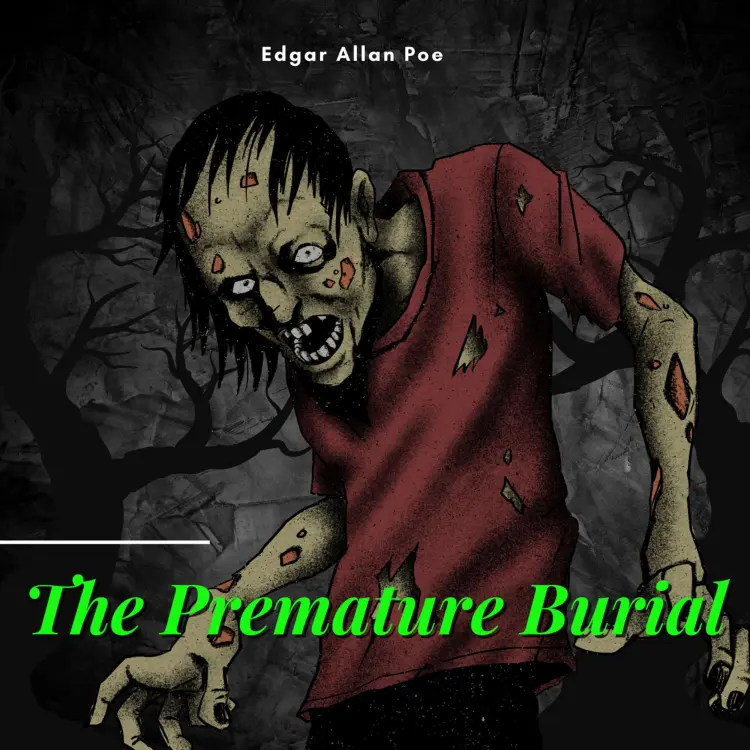
The Premature Burial
Edgar Allan Poe
Unabridged
38 minutes
Note: Costs may be incurred for playing the audio books or audio plays on the respective platforms, e.g. Spotify. Lismio has no influence on which audiobooks and audio plays are available on the service.
Some articles contain affiliate links (marked with an asterisk *). If you click on these links and purchase products, we will receive a small commission at no extra cost to you. Your support helps to keep this site running and to continue creating useful content. Thank you for your support!
From the publisher
The Premature Burial by Edgar Allan Poe is a horror short story by American writer Edgar Allan Poe, published in 1844 in The Philadelphia Dollar Newspaper. Its main character expresses concern about being buried alive. This fear was common in this period and Poe was taking advantage of the public interest. The story has been adapted to a film.
Plot:
In "The Premature Burial", the first-person unnamed narrator describes his struggle with things such as "attacks of the singular disorder which physicians have agreed to term catalepsy", a condition where he randomly falls into a death-like trance. This leads to his fear of being buried alive ("The true wretchedness", he says, is "to be buried while alive"). He emphasizes his fear by mentioning several people who have been buried alive. In the first case, the tragic accident was only discovered much later, when the victim's crypt was reopened. In others, victims revived and were able to draw attention to themselves in time to be freed from their ghastly prisons.
The narrator reviews these examples in order to provide context for his nearly crippling phobia of being buried alive. As he explains, his condition made him prone to slipping into a trance state of unconsciousness, a disease that grew progressively worse over time. He became obsessed with the idea that he would fall into such a state while away from home, and that his state would be mistaken for death. He extracts promises from his friends that they will not bury him prematurely, refuses to leave his home, and builds an elaborate tomb with equipment allowing him to signal for help in case he should awaken after "death".
The story culminates when the narrator awakens in pitch darkness in a confined area. He presumes he has been buried alive, and all his precautions were to no avail. He cries out and is immediately hushed; he quickly realizes that he is in the berth of a small boat, not a grave. The event shocks him out of his obsession with death, and soon after, his catalepsy episodes cease entirely, leading him to suspect that they were a symptom of his phobia, rather than a cause.
Plot:
In "The Premature Burial", the first-person unnamed narrator describes his struggle with things such as "attacks of the singular disorder which physicians have agreed to term catalepsy", a condition where he randomly falls into a death-like trance. This leads to his fear of being buried alive ("The true wretchedness", he says, is "to be buried while alive"). He emphasizes his fear by mentioning several people who have been buried alive. In the first case, the tragic accident was only discovered much later, when the victim's crypt was reopened. In others, victims revived and were able to draw attention to themselves in time to be freed from their ghastly prisons.
The narrator reviews these examples in order to provide context for his nearly crippling phobia of being buried alive. As he explains, his condition made him prone to slipping into a trance state of unconsciousness, a disease that grew progressively worse over time. He became obsessed with the idea that he would fall into such a state while away from home, and that his state would be mistaken for death. He extracts promises from his friends that they will not bury him prematurely, refuses to leave his home, and builds an elaborate tomb with equipment allowing him to signal for help in case he should awaken after "death".
The story culminates when the narrator awakens in pitch darkness in a confined area. He presumes he has been buried alive, and all his precautions were to no avail. He cries out and is immediately hushed; he quickly realizes that he is in the berth of a small boat, not a grave. The event shocks him out of his obsession with death, and soon after, his catalepsy episodes cease entirely, leading him to suspect that they were a symptom of his phobia, rather than a cause.








